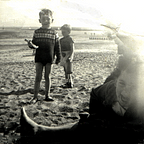What is Bloomsday?
Joyce set the bar high in memorialising a first date
Ulysses (1922) is long novel about a single summer’s day (June 16, 1904). This date, which has become known as Bloomsday, had a special significance for Joyce, as was when he first went out with his future wife, Nora Barnacle.
Famously, very little happens in Ulysses. For 265,000 words we share the lives of three Dubliners:
- Stephen Dedalus is James Joyce’s literary alter ego who at the end of A Portrait of the Artist as Young Man was promising to fly by the nets of religion, politics and nationality. Here he is a recently bereaved, morose young graduate & ‘impossible person’. Teaches part time and contemplates a return to the continent.
- Leopold Bloom (a middle-aged sales representative of Jewish origin). Has one daughter (with expensive tastes) and an affable temperament.
- Molly Bloom (unfaithful wife of Leopold and occasional singer). A vibrant life force with many suitors. Modelled on Nora Barnacle.
All the action takes place in and around Dublin.
Structure
The principal characters correspond the protagonists of Homer’s Odyssey but there are no sea battles or physical heroics or magical interventions. Bloom’s odyssey is his sales-round in Dublin, the antithesis of an epic sea journey. He encounters Hades at a friend’s funeral and Cyclops in the uncouth form of the Citizen: a loud-mouth ultra-nationalist.
Most of Bloom’s meandering is mundane. The main event of the morning, which starts with making breakfast for Molly and the cat, is the funeral of Paddy Dignam, a business acquaintance. There Bloom meets other work associates who exchange the latest gossip.
A cheese-sandwich lunch at a raucous pub is rudely interrupted by a nationalist anti-Semite. Bloom departs, shielded by Shakespeare lookalike Martin Cunningham just as Stephen is arriving. This is a consistent pattern: the two men cover similar ground but at different times
The dutiful Bloom completes other errands. He visits a pharmacy to order ointment for his wife and a newspaper office to place an advertisement. He drops in at the maternity hospital to check on a family friend.
Stephen Dedalus’s day has been more restless, reflecting his unsettled personality and the more socially elevated circles he moves in. Morning consists of a series of uncomfortable encounters: with friend Buck Mulligan, his headmaster/employer and a former teacher.
At the National Library Stephen discusses Shakespeare and Hamlet in eminent company: including the poet AE. This permits much learned showing off from all concerned, and an amplification of the Stephen/Hamlet link.
After that its pretty much downhill all the way for Stephen. Heavy drinking during the evening, is followed by expulsion from a brothel for poor behaviour. Then he gets into a fight with an off-duty British soldier. It is after this ignominious low point that Bloom is ‘rescued’ by the gentle Bloom.
Father and Son?
The paternal/filial relationship is at the hear of the story but only tangentially in the events of the day. Bloom is from a different social world to Stephen/Telemachus, his surrogate ‘son’ and would not have met him in normal circumstances.
He takes Stephen to a cabman’s shelter for food and talk, and then, long after midnight, the two head for Bloom’s home for nightcap. When Stehen leaves, Bloom rejoins his wife in bed, where she has been most of the day.
The novel concludes with Molly’s 4,000 word single-sentence soliloquy. This culminates in an ecstatic endorsement of Bloom: “yes I said yes I will Yes.”
Why all the fuss? One factor is that Joyce offers endless opportunities for scholarly disputation. Even the the pronunciation of the book’s title is haggled over:
Ulysses has traditionally been stressed on the second syllable, in accord with the original Latin. It still is, in US English especially. But often it is stressed on the first syllable instead, notably in the UK and Ireland when referring to the novel. Whichever syllable Joyce himself stressed, he pronounced the word as “oulissays” or “oolissays”,[3] very close to the original Latin (no initial “y” sound, for example)
Ultimately, however, Bloomsday is Joyce’s rejoinder to the Citizen. It is an expression of love — of language and life to countern ‘force, hatred, history’. And ultimately a valentine to the hotel maid who inspired the most discussed novel of the Twentieth Century.
